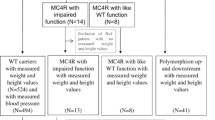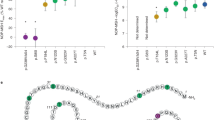Abstract
To acquire more information relative to the course of obesity in conditions of food restriction in subjects carrying mutations in the melanocortin signaling pathway, 710 obese children (mean age: 9.5±2.1 yr; mean z-score body mass index: 3.63±1.6) were genotyped for the proopiomelanocortin (POMC) R236G substitution, a variant which has been associated to early onset obesity, by restriction fragment length polymorphism (RFLP) analysis. Three children were heterozygotes for the R236G variant (0.4%). One of them had the metabolic syndrome. This variant was not found in 400 controls. The 3 probands followed a hypocaloric balanced diet and, after about 12 months, normalized their weight as well as fat mass and insulin resistance. The patient with the metabolic syndrome reversed this condition. These results show that a) the R236G substitution of POMC gene, although not a major cause of obesity among Italian obese children and adolescents, is associated with early onset obesity, and that b) inherited alterations of the melanocortin signaling pathway, independently of the degree of obesity, do not preclude the possibility to lose weight in mutated individuals following a hypocaloric diet. (J. Endocrinol. Invest. 29: 226–230, 2006)
Similar content being viewed by others
References
Sokol RJ. The chronic disease of childhood obesity: the sleeping giant has awakened (editorial). J Pediatr 2000, 136: 711–3.
Schwartz MW, Woods SC, Porte D Jr, et al. Central nervous system control of food intake. Nature 2000, 404: 661–71.
Barsh GS, Farooqui IS, O’Rahilly S. Genetics of body-weight regulation: Nature 2000, 404: 644–51.
Takahashi H, Teranishi Y, Nakanishi S, et al. Isolation and structural organization of the human corticotropin-β-lipotropin precursor gene. FEBS Lett 1981, 135: 97–101.
Gantz I, Miwa H, Konda Y, et al. Molecular cloning, expression, and gene localization of a fourth melanocortin receptor. J Biol Chem 1993, 268: 15174–9.
Swartz MW, Seeley RJ, Woods SC, et al. Leptin increases hypotalamic pro-opiomelanocortin mRNA expression in the rostral arcuate nucleus. Diabetes 1997, 46: 2119–23.
Vaisse C, Clement K, Guy-Grand B, et al. A frameshift mutation in human MC4R is associated with a dominant form of obesity. Nat Genet 1998, 20: 113–4.
Yeo GS, Farooqi IS, Aminian S, et al. A frame shift mutation in MC4R associated with dominantly inherited human obesity. Nat Genet 1998, 20: 111–2.
Gu W, Tu Z, Kleyn PW, et al. Identification and functional analysis of novel human melanocortin-4 receptor variants. Diabetes 1999, 48: 635–9.
Hinney A, Schmidt A, Nottebom K, et al. Several mutations in the melanocortin-4 receptor gene including a nonsense and a frameshift mutation associated with dominantly inherited obesity in humans. J Clin Endocrinol Metab 1999, 84: 1483–6.
Farooqi IS, Yeo GS, Keogh JM, et al. Dominant and recessive inheritance of morbid obesity associated with melanocortin 4 receptor deficiency. J Clin Invest 2000, 106: 271–9.
Miraglia del Giudice E, Cirillo G, Nigro V, et al. Low frequency of melanocortin-4 receptor (MC4R) mutations in a Mediterranean population with early-onset obesity. Int J Obes Relat Metab Disord 2002, 26: 647–51.
Farooqi IS, Keogh JM, Yeo GSH, et al. Clinical spectrum of obesity and mutations in the melanocortin 4 receptor gene. N Engl J Med 2003, 348: 1085–95.
Krude H, Biebermann H, Luck W, et al. Severe early onset obesity, adrenal insufficiency and red hair pigmentation caused by POMC mutations in humans. Nat Genet 1998, 19: 155–7.
Hinney A, Becker I, Heibult O, et al. Systematic mutation screening of the proopiomelanocortin gene: identification of several genetic variants including three different insertions, one nonsense and two missense point mutations in probands of different weight extremes. J Clin Endocrinol Metab 1998, 83: 3737–41.
Miraglia del Giudice E, Cirillo G, Santoro N, et al. Molecular screening of the proopiomelanocortin (POMC) gene in Italian obese children: report of three new mutations. Int J Obes Relat Metab Disord 2001, 25: 61–5.
Challis BG, Pritchard LE, Creemers JW, et al. A missense mutation disrupting a dibasic prohormone processing site in pro-opiomelanocortin (POMC) increases susceptibility to early-onset obesity through a novel molecular mechanism. Hum Mol Genet 2002, 11: 1997–2004.
Expert Panel on Detection, Evaluation, and Treatment of High Blood Cholesterol in Adults. Executive summary of the third report of the National Cholesterol Education Program (NCEP) Expert Panel on Detection, Evaluation, and Treatment of High Blood Cholesterol in Adults (Adult Treatment Panel III): JAMA 2001, 285: 2486–97.
Ste. Marie L, Miura GI, Marsh DJ, et al. A metabolic defect promotes obesity in mice lacking melanocortin-4 receptors. Proc Natl Acad Sci USA 2000, 97: 12339–44.
Rolland-Cachera MF, Cole TJ, Sempé M, et al. Variation of the Wt/Hr2 index from birth to 87 years. Eur J Clin Nutr 1991, 45: 13–21.
Zannolli R, Morgese G. Waist percentiles: a simple test for atherogenic disease? Acta Paediatr 1996, 85: 1368–9.
Tanner JM, Whitehouse RH, Takaishi M. Standards from birth to maturity for height, weight, height velocity and weight velocity: British children, 1965. Arch Dis Child 1996, 41: 454–71.
Tanner JM, Whitehouse RH, Takaishi M. Standards from birth to maturity for height, weight, height velocity and weight velocity: British children, 1965. Arch Dis Child 1996, 41: 613–35.
Tanner JM, Whitehouse RH, Cameran N, et al. Assessment of skeletal maturity and prediction of adult height (TW2 method), 3nd ed. Academic Press Limited. 1988.
Schofield WN. Predicting basal metabolic rate, new standards and review of previous work. Hum Nutr Clin Nutr 1985, 39c (Suppl 1): 5–42.
Update on the 1987 Task Force Report on High Blood Pressure in Children and Adolescents: a working group report from the National High blood Pressure Education Program. Pediatrics 1996, 98: 649–58.
Author information
Authors and Affiliations
Corresponding author
Rights and permissions
About this article
Cite this article
Santoro, N., Perrone, L., Cirillo, G. et al. Weight loss in obese children carrying the proopiomelanocortin R236G variant. J Endocrinol Invest 29, 226–230 (2006). https://doi.org/10.1007/BF03345544
Accepted:
Published:
Issue Date:
DOI: https://doi.org/10.1007/BF03345544




